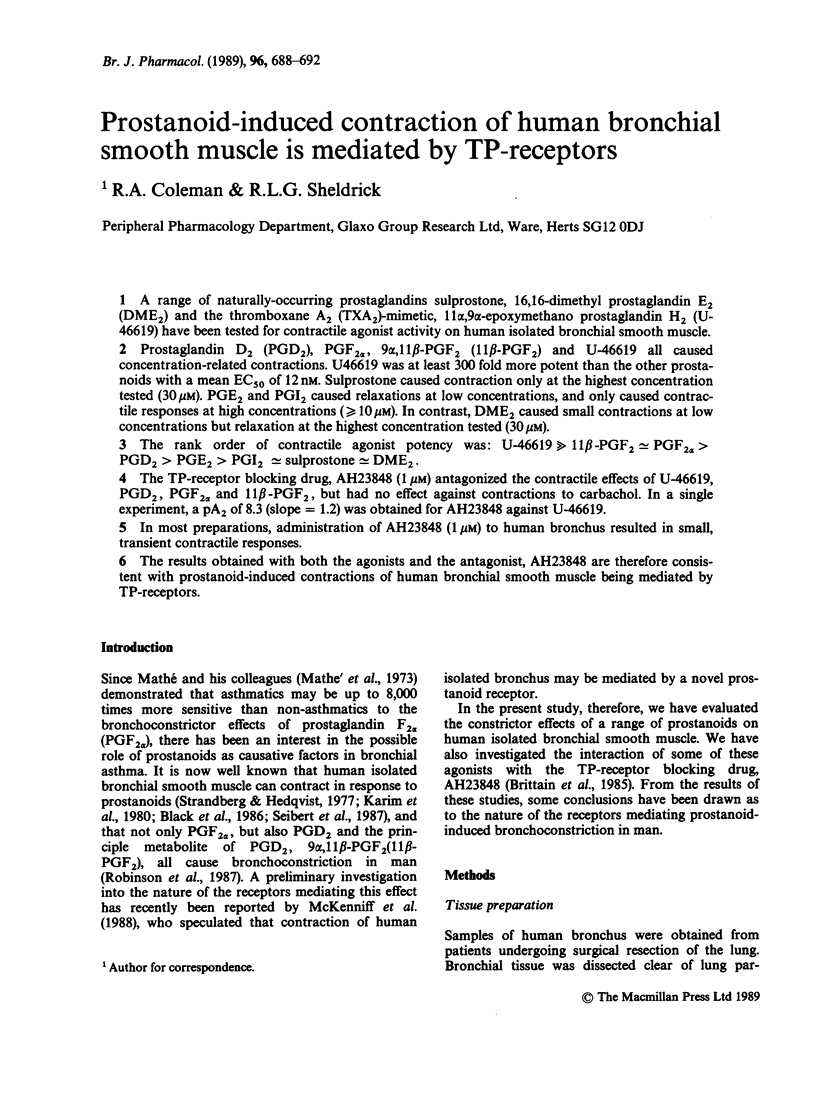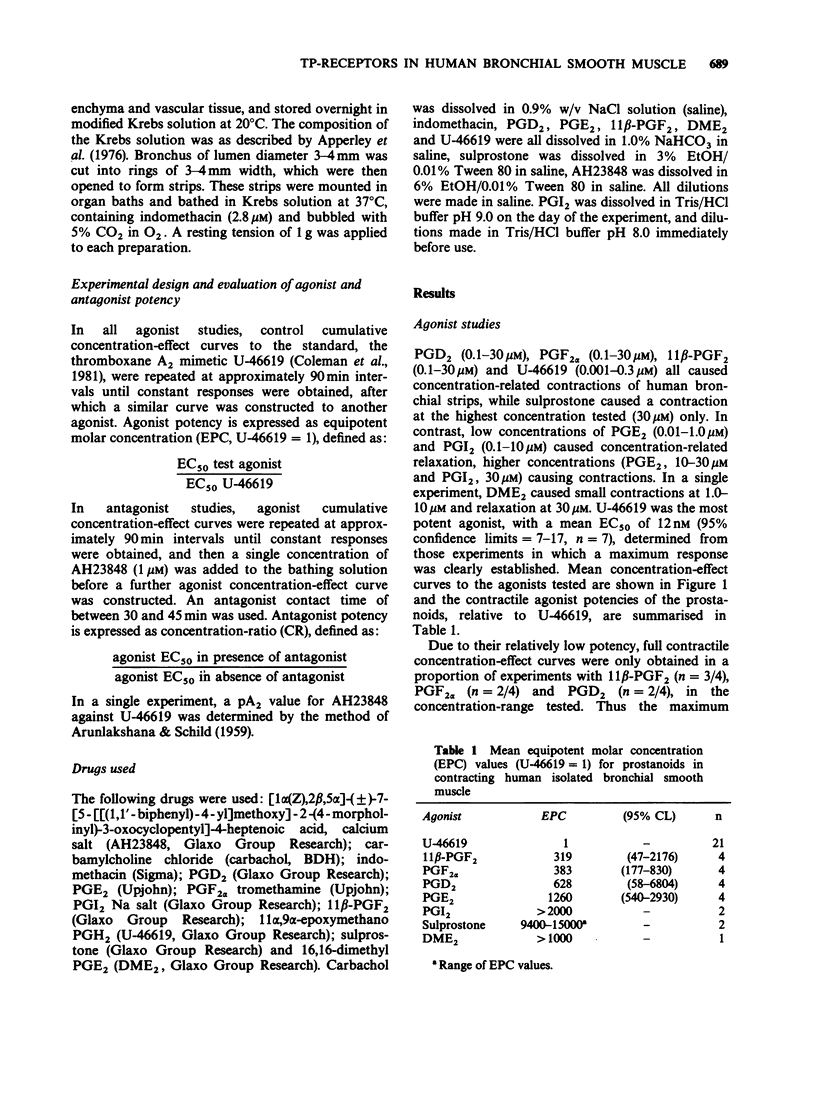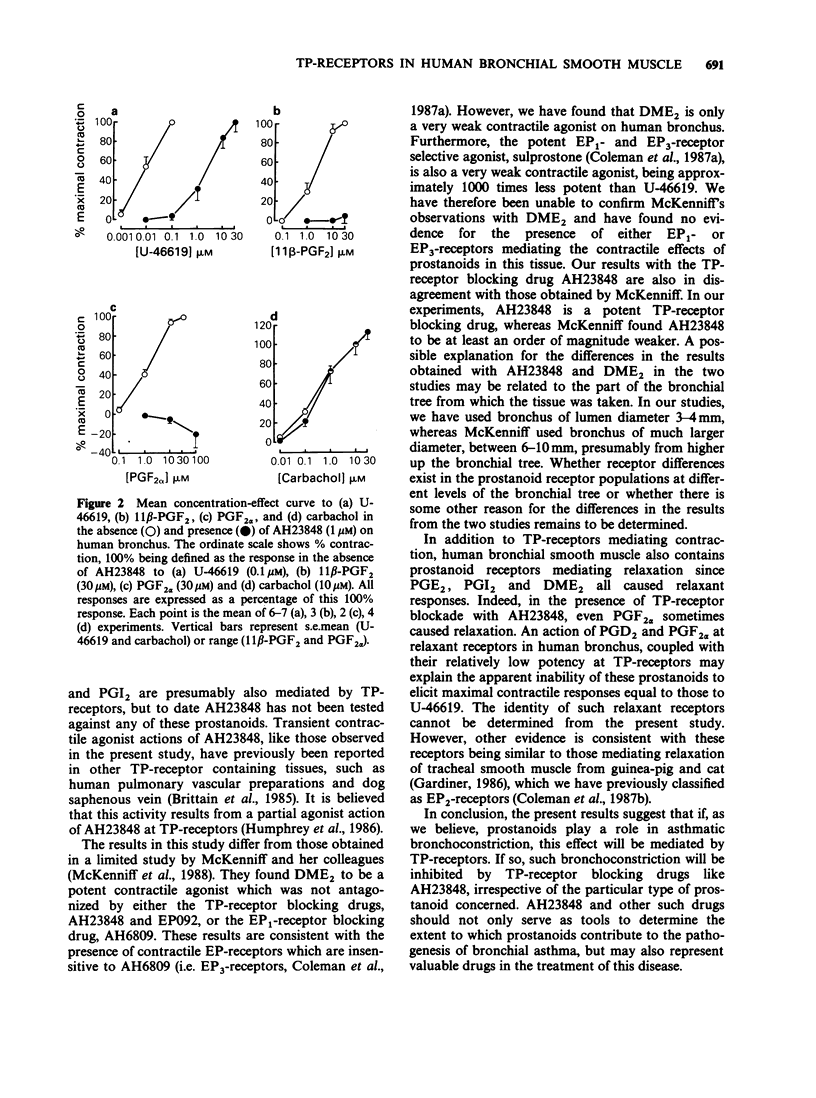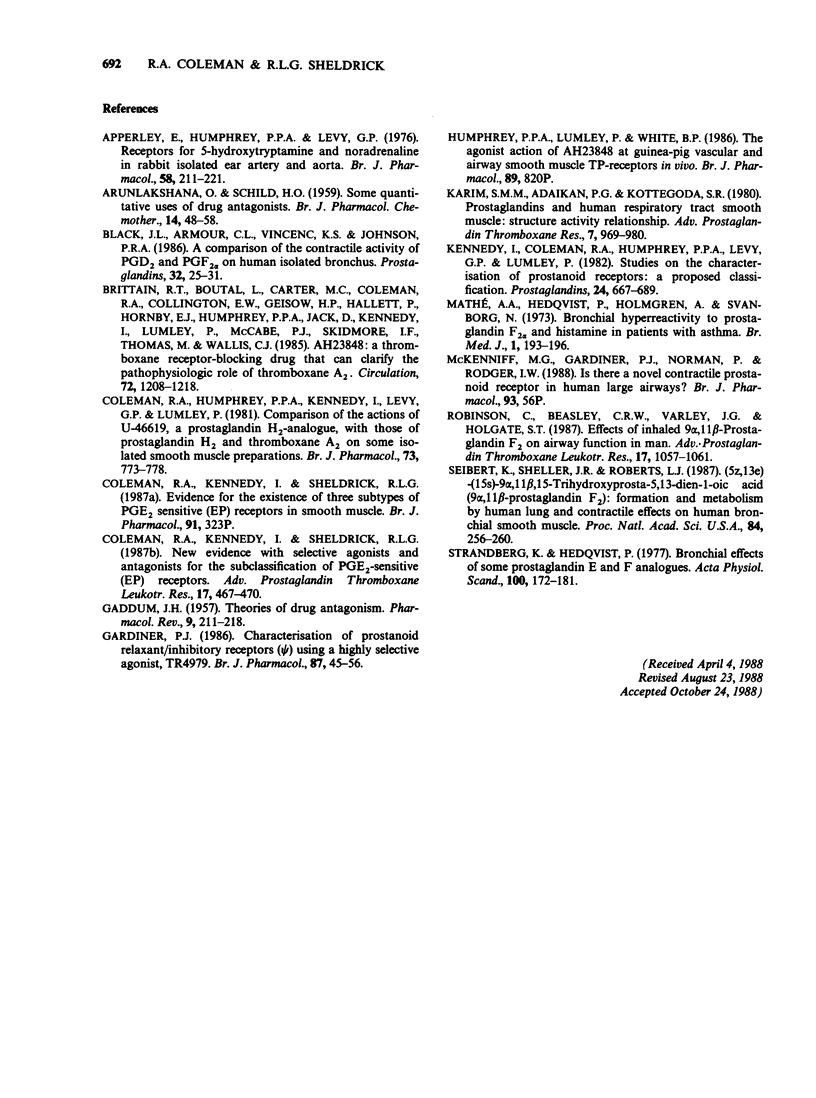Abstract
1. A range of naturally-occurring prostaglandins sulprostone, 16,16-dimethyl prostaglandin E2 (DME2) and the thromboxane A2 (TXA2)-mimetic, 11 alpha,9 alpha-epoxymethano prostaglandin H2 (U-46619) have been tested for contractile agonist activity on human isolated bronchial smooth muscle. 2. Prostaglandin D2 (PGD2), PGF2 alpha, 9 alpha,11 beta-PGF2 (11 beta-PGF2) and U-46619 all caused concentration-related contractions. U46619 was at least 300 fold more potent than the other prostanoids with a mean EC50 of 12 nM. Sulprostone caused contraction only at the highest concentration tested (30 microM). PGE2 and PGI2 caused relaxations at low concentrations, and only caused contractile responses at high concentrations (greater than or equal to 10 microM). In contrast, DME2 caused small contractions at low concentrations but relaxation at the highest concentration tested (30 microM). 3. The rank order of contractile agonist potency was: U-46619 much greater than 11 beta-PGF2 congruent to PGF2 alpha greater than PGD2 greater than PGE2 greater than PGI2 congruent to sulprostone congruent to DME2. 4. The TP-receptor blocking drug, AH23848 (1 microM) antagonized the contractile effects of U-46619, PGD2, PGF2 alpha and 11 beta-PGF2, but had no effect against contractions to carbachol. In a single experiment, a pA2 of 8.3 (slope = 1.2) was obtained for AH23848 against U-46619. 5. In most preparations, administration of AH23848 (1 microM) to human bronchus resulted in small, transient contractile responses. 6. The results obtained with both the agonists and the antagonist, AH23848 are therefore consistent with prostanoid-induced contractions of human bronchial smooth muscle being mediated by TP-receptors.
Full text
PDF




Selected References
These references are in PubMed. This may not be the complete list of references from this article.
- ARUNLAKSHANA O., SCHILD H. O. Some quantitative uses of drug antagonists. Br J Pharmacol Chemother. 1959 Mar;14(1):48–58. doi: 10.1111/j.1476-5381.1959.tb00928.x. [DOI] [PMC free article] [PubMed] [Google Scholar]
- Apperley E., Humphrey P. P., Levy G. P. Receptors for 5-hydroxytryptamine and noradrenaline in rabbit isolated ear artery and aorta. Br J Pharmacol. 1976 Oct;58(2):211–221. doi: 10.1111/j.1476-5381.1976.tb10398.x. [DOI] [PMC free article] [PubMed] [Google Scholar]
- Black J. L., Armour C. L., Vincenc K. S., Johnson P. R. A comparison of the contractile activity of PGD2 and PGF2 alpha on human isolated bronchus. Prostaglandins. 1986 Jul;32(1):25–31. doi: 10.1016/0090-6980(86)90139-5. [DOI] [PubMed] [Google Scholar]
- Brittain R. T., Boutal L., Carter M. C., Coleman R. A., Collington E. W., Geisow H. P., Hallett P., Hornby E. J., Humphrey P. P., Jack D. AH23848: a thromboxane receptor-blocking drug that can clarify the pathophysiologic role of thromboxane A2. Circulation. 1985 Dec;72(6):1208–1218. doi: 10.1161/01.cir.72.6.1208. [DOI] [PubMed] [Google Scholar]
- Coleman R. A., Humphrey P. P., Kennedy I., Levy G. P., Lumley P. Comparison of the actions of U-46619, a prostaglandin H2-analogue, with those of prostaglandin H2 and thromboxane A2 on some isolated smooth muscle preparations. Br J Pharmacol. 1981 Jul;73(3):773–778. doi: 10.1111/j.1476-5381.1981.tb16814.x. [DOI] [PMC free article] [PubMed] [Google Scholar]
- GADDUM J. H. Theories of drug antagonism. Pharmacol Rev. 1957 Jun;9(2):211–218. [PubMed] [Google Scholar]
- Gardiner P. J. Characterization of prostanoid relaxant/inhibitory receptors (psi) using a highly selective agonist, TR4979. Br J Pharmacol. 1986 Jan;87(1):45–56. doi: 10.1111/j.1476-5381.1986.tb10155.x. [DOI] [PMC free article] [PubMed] [Google Scholar]
- Karim S. M., Adaikan P. G., Kottegoda S. R. Prostaglandins and human respiratory tract smooth muscle: structure activity relationship. Adv Prostaglandin Thromboxane Res. 1980;7:969–980. [PubMed] [Google Scholar]
- Kennedy I., Coleman R. A., Humphrey P. P., Levy G. P., Lumley P. Studies on the characterisation of prostanoid receptors: a proposed classification. Prostaglandins. 1982 Nov;24(5):667–689. doi: 10.1016/0090-6980(82)90036-3. [DOI] [PubMed] [Google Scholar]
- Mathé A. A., Hedqvist P., Holmgren A., Svanborg N. Bronchial hyperreactivity to prostaglandin F 2 and histamine in patients with asthma. Br Med J. 1973 Jan 27;1(5847):193–196. doi: 10.1136/bmj.1.5847.193. [DOI] [PMC free article] [PubMed] [Google Scholar]
- Robinson C., Beasley C. R., Varley J. G., Holgate S. T. Effects of inhaled 9 alpha, 11 beta-prostaglandin F2 on airway function in man. Adv Prostaglandin Thromboxane Leukot Res. 1987;17B:1057–1061. [PubMed] [Google Scholar]
- Seibert K., Sheller J. R., Roberts L. J., 2nd (5Z,13E)-(15S)-9 alpha,11 beta,15-trihydroxyprosta-5,13-dien-1-oic acid (9 alpha,11 beta-prostaglandin F2): formation and metabolism by human lung and contractile effects on human bronchial smooth muscle. Proc Natl Acad Sci U S A. 1987 Jan;84(1):256–260. doi: 10.1073/pnas.84.1.256. [DOI] [PMC free article] [PubMed] [Google Scholar]
- Strandberg K., Hedqvist P. Bronchial effects of some prostaglandin E and F analogues. Acta Physiol Scand. 1977 Jun;100(2):172–181. doi: 10.1111/j.1748-1716.1977.tb05934.x. [DOI] [PubMed] [Google Scholar]


